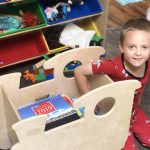This post may contain affiliate links. Click here to read my affiliate disclaimer policy.

Is your sunscreen toxic? Maybe you haven’t thought about the toxic ingredients that are lurking in your favorite sunscreen. Maybe you love the tropical scent or the way it glides on effortlessly. Or maybe you remember wearing that brand since you were a kid and wonder how it could ever do you wrong.
Sadly, many sunscreens contain an alarming amount of chemicals that are known to be toxic to our health. These chemicals soak into our skin, entering our bloodstream. Traces of these chemicals can be found in our blood, urine and breast milk for up to 2 days after only one use.
Is Your Sunscreen Toxic?
It is no surprise that another study recently came out from the FDA stating the dangers of these chemicals and how they are absorbed into the bloodstream with only a single use.
Chemicals commonly found in sunscreens include:
- Avobenzone
- Oxybenzone
- Octinoxate
- Homosalate
- Octisalate
- Octocrylene
- Fragrance
Check your sunscreen’s label! I am sure you will see one of these ingredients on there.
These chemicals penetrate through the skin and may disrupt hormones, reproductive and thyroid systems, cause skin allergies, and expose your unborn baby when worn by pregnant women.
Fragrance is an ingredient that may contain hundreds, even thousands of chemicals, many linked to cancer.
The better choices are mineral-based sunscreens made from non-nano zinc oxide and/or titanium dioxide. You may find sunscreens with zinc or titanium dioxide as the main ingredient, but be careful, because sometimes these sunscreens contain some of the chemicals listed above in their inactive ingredient list.
More about chemical sunscreens:
Note: This section was taken from EWG.org
“Nearly every chemical sunscreen in the United States contains avobenzone because it is the best available agent for filtering skin-damaging UVA rays. However, avobenzone alone may break down when exposed to sunlight and must be stabilized with other chemicals such as octocrylene.
Laboratory studies of several sunscreen chemicals indicate that they may mimic hormones and disrupt the hormone system (Krause 2012, Schlumpf 2001, 2004, 2008). Some research on animals suggests that oxybenzone and other sunscreen chemicals can be toxic to reproductive systems or interfere with normal development. (See Table 1) Another sunscreen chemical, 4-methylbenzidyl camphor, used in Europe and under petition for use in the United States is also a hormone disruptor.
Experts caution that the unintentional exposure to and toxicity of active ingredients erodes the benefits of sunscreens (Krause 2012, Schlumpf 2010). But most conclude that more sensitive tests are needed to determine whether sunscreen chemicals ingredients pose risks to sunscreen users (Draelos 2010, Gilbert 2013). Generally, chemical sunscreens deserve special scrutiny because most are known to permeate the skin to some degree.
Two European studies have detected sunscreen chemicals in mothers’ milk, indicating that the developing fetus and newborns may be exposed to these substances (Schlumpf 2008, Schlumpf 2010). A 2010 study by Margaret Schlumpf of the University of Zurich found at least one sunscreen chemical in 85 percent of milk samples.
The most problematic of the sunscreen chemicals used in the U.S. is oxybenzone, found in nearly every chemical sunscreen. EWG recommends that consumers avoid this chemical because it can penetrate the skin, cause allergic skin reactions and may disrupt hormones (Calafat 2008, Rodriguez 2006, Krause 2012). Preliminary investigations of human populations suggest a link between higher concentrations of oxybenzone and its metabolites in the body and increased risk of endometriosis and lower birthweight in daughters (Kunisue 2012, Wolff 2008).
The federal Centers for Disease Control and Prevention has detected oxybenzone in more than 96 percent of the American population, based on a representative sampling of more than 2,500 children and adults (Calafat 2008). Researchers found higher concentrations of oxybenzone in samples collected from participants during the summer months, and concluded that sunscreen use may explain this seasonal difference.”
What are the safest sunscreens?
The best natural sunscreens I have found so far with an EWG rating of 1 (safest rating on a scale of 1-10) are below. As you may notice, a lot of the store-bought mainstream brands are not on this list – and for good reasons! Just because it says “natural” or “dermatologist recommended” or even “oxybenzone free” does not always mean it is safe or free of toxic chemicals.
Reef safe sunscreen should also be something to consider. I have found some reef safe natural sunscreens I love which include:



OR Check The Score Of Your Favorite Sunscreen Here!
Make changes and eliminate toxins from your life!
The bottom line is – always check your labels, on everything! If you don’t know about the ingredient/s, look it up and check the rating on EWG.org! This goes for food, lotions, baby wipes, makeup and anything you would put in or on your body. Small changes like swapping out your favorite products for healthier alternatives can make all the difference.
Some toxins we simply cannot avoid (polluted air, etc.), but we can certainly make decisions on the products we buy. EWG is an amazing website and resource to use. I love their mobile app too, which allows you to scan products from the store on your phone, so you can make an educated choice before you spontaneously buy something.
Now get outside and protect your skin naturally! Also check out our post about toxins in beauty products.
Amazon and the Amazon logo are trademarks of Amazon.com, Inc, or its affiliates.





